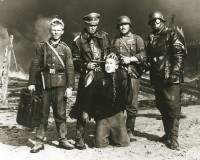Killing Hitler: Come and See
Dmitri Prieto

For Quentin Tarantino, Come and See is the best movie on World War II (The 50 Greatest World War II movies: Part six with Time Out Film). They showed it on Cuban TV a few days ago (though I don’t know if it was a rerun, so perhaps it was a premiere). It came on right on the eve of the failed Führer’s birthday.
Its showing was a good gesture for putting historical justice in its place, much better than organizing Bonapartist ceremonies [see “So Now the Bonapartists Too?” Part I and Part II). Today is May 9, the day of victory for those who live or were born east of the meridian that crosses Berlin. This is why I’m thinking back and writing these lines.
Incredibly, this was the first time I ever saw Come and See, even though it was filmed in Russia when I lived there as a boy and despite the fact that many friends here in Cuba later recommended it to me.
It’s a film that doesn’t cease to impress, and many people here associate it in their minds with that epoch of opening in the 1980s (that one Irina knows how to describe much better than me because my tendency is to submerge myself in my own traumas and not to open my heart to such powerful stimuli).
When they first showed Come and See in the cinemas here in Havana, people were impressed by a narrative that was so different from the classic Soviet style of making movies about the war.
My Cuban friends were impressed by the expressionist aesthetic of the work. It doesn’t stop being almost a documentary while at the same time discovering ways of finding common ground between the great Russian director Andrei Tarkovsky and several great Cuban directors.
Realist to the marrow, this film puts into the mind of those who watch it a Belarusian boy who lives in a village in the midst of war. There are no considerations. The traditional stereotypes are gone – except for those that tie together the basic antagonism between “us” and “the fascists.”
Human wickedness appears in its most distilled and unpredictably varying form. If it were not for the Soviet ethos — which is unpardonably introduced through the movie’s still photographs — the film would have been a classic example of how art serves to transmit the spirituality of massacre; meaning that the spirituality of the massacre doesn’t stop being, it’s just that something remains beyond it.
Perhaps more for reasons of the box office, the title selected in Spain was Masacre: ve y mira” (Massacre: Come and See). In Cuba, however, the original from Bible was maintained (from Revelations 6:7-8, the passage after the passing of the Four Horsemen).
The original title was “Killing Hitler,” which the censors asked director Elem Klimov to change, together with a series of other aspects for the sake of “humanizing” the work. Klimov only conceded to the title change, and nothing else. Perhaps this was the only time Soviet censors actually did something right.
But killing Hitler was possibly the aim of Come and See. After the Nazis burn the village and slaughter almost all of its residents, the young leading character — who we see age before our eyes — takes out his rage by shooting a poster of the Führer.
In that scene we see the images in the mind of the boy. Hitlerian time runs backwards as we’re shown various shots from Nazi Party congresses of the 1930s and torch-lite marches of the ‘20s, and finally a young Hitler in his mother’s arms. At that point, the now-matured Belarusian orphan lowers the rifle and refuses to continue shooting.





